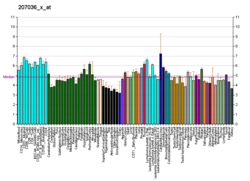| GRIN2D | |||||||||||||||||||||||||||||||||||||||||||||||||||
|---|---|---|---|---|---|---|---|---|---|---|---|---|---|---|---|---|---|---|---|---|---|---|---|---|---|---|---|---|---|---|---|---|---|---|---|---|---|---|---|---|---|---|---|---|---|---|---|---|---|---|---|
| Identifiers | |||||||||||||||||||||||||||||||||||||||||||||||||||
| Aliases | GRIN2D , EB11, GluN2D, NMDAR2D, NR2D, glutamate ionotropic receptor NMDA type subunit 2D, EIEE46, DEE46 | ||||||||||||||||||||||||||||||||||||||||||||||||||
| External IDs | OMIM: 602717; MGI: 95823; HomoloGene: 648; GeneCards: GRIN2D; OMA:GRIN2D - orthologs | ||||||||||||||||||||||||||||||||||||||||||||||||||
| |||||||||||||||||||||||||||||||||||||||||||||||||||
| |||||||||||||||||||||||||||||||||||||||||||||||||||
| |||||||||||||||||||||||||||||||||||||||||||||||||||
| |||||||||||||||||||||||||||||||||||||||||||||||||||
| Wikidata | |||||||||||||||||||||||||||||||||||||||||||||||||||
| |||||||||||||||||||||||||||||||||||||||||||||||||||
This article is missing information about the dangerous condition of malfunctioning of this gene.(June 2025) |
Glutamate [NMDA] receptor subunit epsilon-4 is a protein that in humans is encoded by the GRIN2D gene. [5] [6] [7]




